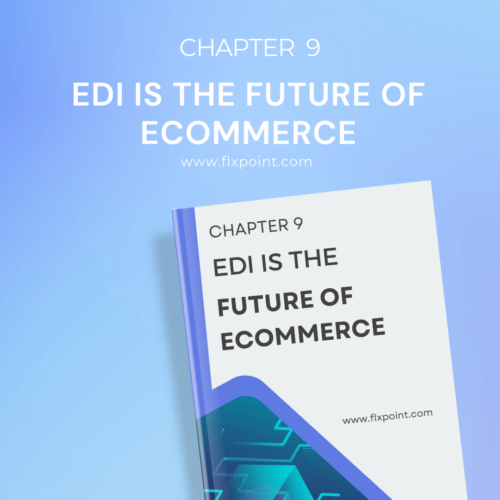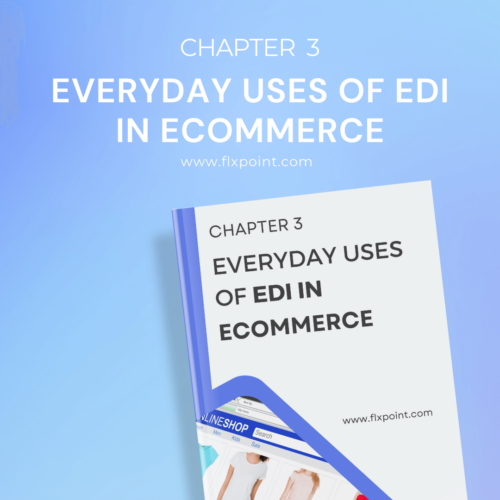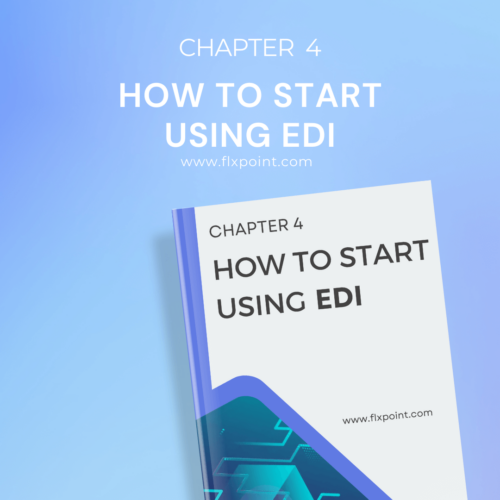Chapter 9 EDI is the Future of Ecommerce
Embrace EDI as the future of your ecommerce strategy. Learn why adopting EDI now positions you for long-term success in a digital world.

Chapter 9: EDI is the Future of Ecommerce
Electronic Data Interchange (EDI) continues to evolve as a crucial technology for ecommerce businesses. According to a recent industry report, the projected growth of the global Electronic Data Interchange (EDI) software market from 2023 to 2028. In 2023, the market size was valued at $2.06 billion and grew to $2.29 billion in 2024.

The current year, 2025, shows continued growth, following a consistent upward trend. By 2028, the market size is expected to reach $3.53 billion. This reflects a compound annual growth rate (CAGR) of 11.4% over the forecast period, indicating increasing global adoption of EDI software solutions.
With the increasing complexity of global supply chains and the demand for faster processing, EDI will play an even bigger role in streamlining operations.
Future Trends in EDI for Ecommerce
As ecommerce evolves, the role of Electronic Data Interchange (EDI) is also transforming to meet new demands. The future lies in leveraging EDI’s strengths while integrating newer technologies like APIs. Here are key trends shaping the future of EDI in ecommerce:
- Hybrid Integration Models
EDI will likely continue to coexist with APIs rather than being replaced by them. Many organizations are adopting a hybrid approach where traditional EDI handles high-volume, standardized transactions while APIs manage real-time, dynamic interactions. This allows businesses to maintain compatibility with established partners while gaining modern integration capabilities.
- Seamless Interoperability: Businesses will need platforms that support both EDI and API integrations, allowing for flexibility in how they connect with suppliers, partners, and sales channels.
- Improved Communication Methods: Hybrid models allow businesses to adapt to partners who prefer traditional EDI formats or newer API-based exchanges.
- Enhanced Data Exchange: By combining the strengths of EDI (structured batch processing) and APIs (real-time communication), businesses can handle diverse data exchange scenarios efficiently.
- Enhanced Automation
Automation will go beyond basic workflows, improving the speed and accuracy of transactions.
- Sophisticated Workflows: Future EDI systems will automate complex, multi-step processes like order confirmations, inventory updates, and shipment tracking.
- Error Handling and Validation: Advanced validation tools will identify and correct issues before they cause disruptions, reducing manual interventions.
- Integration with Existing Systems: EDI platforms will offer better compatibility with modern ERP, CRM, and order management systems, streamlining overall operations.
- Efficiency Gains: Faster processing and reduced manual effort will help businesses scale operations while maintaining high accuracy.
- Scalability Requirements
As your ecommerce businesses grow, the need for scalable solutions that handle large transaction volumes and multiple channels becomes critical.
- Batch Processing Advantages: EDI’s ability to process large batches of transactions will remain essential for businesses managing high order volumes.
- Multi-Channel Capabilities: Systems will need to integrate seamlessly across multiple sales channels, including marketplaces, direct-to-consumer platforms, and wholesale operations.
- Reliable Data Syncing: Real-time synchronization of inventory, order, and shipment data across channels will prevent errors like overselling or stockouts, even as transaction volumes grow.
- Shift Towards In-House EDI Processing for All Business Sizes
As eCommerce businesses scale and transaction volumes grow, larger companies are moving away from outsourcing EDI processing due to the rising costs and are opting for in-house solutions. This shift offers better control and cost savings, enabling more efficient management of EDI operations.
- Better Control and Cost Savings: In-house solutions provide companies with greater control over their EDI processes while reducing long-term outsourcing costs.
- Increased Flexibility: Businesses can customize their EDI workflows to better suit their unique needs.
- Cloud-Based Solutions for Small Businesses: Smaller companies are turning to SaaS and iPaaS models, offering scalable, cost-effective in-house EDI solutions without high upfront investments.
- Efficient Management of High-Transaction Loads: Some advanced iPaaS platforms now support large transaction volumes, allowing even smaller businesses to handle complex operations with ease. This removes the need for larger businesses to maintain dedicated in-house teams for EDI processing, as the iPaaS platform can efficiently manage the heavy transaction load.
This allows companies of all sizes to benefit from the flexibility, automation, and scalability of cloud-based integration solutions, streamlining their operations while reducing the need for extensive internal resources.
- Ongoing Importance of Standardization in Data Exchange
While new technologies like APIs are being adopted, the fundamental need for standardization in B2B transactions will persist. EDI’s long-standing role in ensuring standardized data formats remains crucial for smooth interoperability between trading partners.As APIs evolve, the challenge of creating universally accepted standards for JSON or XML messages remains, meaning EDI will continue to play a pivotal role in managing standardized, high-volume data exchanges until such standards are established for APIs.
- Consistency Across Systems: Standardized data formats are essential to ensure seamless communication between diverse systems and partners.
- Reliable Integration: The ongoing need for structured data flow in high-volume transactions means that EDI will continue to complement emerging technologies until universal API standards are defined.
- AI and Machine Learning Integration for Smarter EDI
As Artificial Intelligence (AI) and Machine Learning (ML) technologies become more sophisticated, their integration into EDI systems will drive further advancements in automation, efficiency, and decision-making.
- Predictive Analytics: AI-powered systems can predict demand patterns and optimize inventory, reducing delays and stockouts.
- Intelligent Routing: ML algorithms will enable smarter routing of data, directing transactions to the most efficient processing systems, improving response times and transaction accuracy.
- Automated Error Detection: Machine learning can help identify unusual patterns or discrepancies in data exchanges, reducing errors and improving data quality without manual intervention.
Why investing in EDI is a smart choice for long-term success?
Automation of Critical Processes
As ecommerce businesses grow, the volume of orders and data increases, making manual data entry more cumbersome and error-prone. EDI automates essential tasks like processing purchase orders, updating inventory, and sending shipment notifications. This automation speeds up operations while reducing human error, ensuring consistency in transactions.
- Practical Impact: The more orders processed, the higher the risk of errors in manual data handling. EDI reduces that risk by enabling direct, automated communication with trading partners, cutting down on mistakes and inefficiencies.
Cost Reduction
While setting up an EDI system requires an upfront investment, the long-term savings are substantial. EDI lowers operational costs in several key ways:
- Reduced labor costs: Less time is spent on data entry and order processing.
- Fewer errors: EDI minimizes mistakes that could lead to shipping issues or inventory problems.
- Lower paper and storage costs: With digital documents, there’s less need for physical storage.
- Faster transaction cycles: Transactions happen more quickly, leading to better cash flow.
Scalability
EDI is highly beneficial as your business expands. For example, it allows you to onboard new vendors quickly and integrate complex systems smoothly, enabling your business to scale without being hindered by manual processes or delays.
- Example: As mentioned in the Jessica Simpson website example, EDI helps businesses manage a growing number of vendors and partners more efficiently, which is crucial for supporting business expansion.
Real-Time Data Synchronization
Real-time data synchronization is a core advantage of EDI. This capability ensures that your inventory, orders, and other critical data are always up-to-date, reducing the risk of issues like overselling or stockouts.
- Improved Accuracy: Real-time updates improve inventory management and foster better relationships with both suppliers and customers, contributing to a more stable business foundation.
Standardization and Flexibility
EDI uses standardized protocols, such as X12, to ensure compatibility between different systems, which helps avoid vendor lock-in. This gives businesses the flexibility to work with multiple partners and adapt to evolving technological requirements as they grow.
- Technical Flexibility: Standardized communication ensures seamless integrations across various systems, facilitating smoother operations as your business grows and connects with more partners.
Alignment with Market Trends
With the ecommerce sector increasingly moving toward automation and digital transformation, having EDI capabilities is quickly becoming a necessity, not just an advantage. As more trading partners adopt EDI, staying competitive in the market requires leveraging this technology.
Long-Term ROI
Though the initial implementation of EDI may require an investment in both time and money, the system typically pays for itself over time through:
- Improved operational efficiency
- Fewer errors and related costs
- Better cash flow management
Choosing the Right EDI Provider
To maximize the value of EDI, it’s essential to partner with experienced EDI providers who understand the specific challenges of ecommerce. These providers can offer both technical expertise and ongoing support, ensuring that your EDI implementation aligns with your unique business needs and delivers a solid return on investment.
Guide Chapters
- Chapter 1: What is EDI?
- Chapter 2: How EDI Helps Ecommerce Businesses
- Chapter 3: Everyday Uses of EDI in Ecommerce
- Chapter 4: How to Start Using EDI
- Chapter 5: Why EDI is Better Than Manual Work
- Chapter 6: EDI vs. APIs: What's the Difference?
- Chapter 7: The Future of EDI in Ecommerce
- Chapter 8: Your First Steps with EDI
- Chapter 9: EDI is the Future of Ecommerce
- Chapter 10: Quick Glossary of EDI terms
- Chapter 11: Checklist to Prepare for EDI Setup
All Chapters in This Guide

Start with the essentials. This chapter breaks down what EDI is, how it works, and why it’s a critical tool for modern ecommerce businesses. We simplify the technical jargon so you can clearly understand how EDI automates the exchange of business documents with your suppliers, warehouses, and trading partners.

Explore the powerful benefits EDI brings to your ecommerce operations. From faster communication and fewer errors to cost savings and improved accuracy, this chapter shows how EDI makes your business leaner, smarter, and more competitive.

See how EDI shows up in real day-to-day workflows. This chapter highlights common applications like order placement, shipping confirmations, inventory updates, and invoicing—so you can understand the practical ways EDI supports smooth operations.

Ready to get started? This chapter walks you through the process of adopting EDI, including evaluating your current tech stack, selecting the right partners, and integrating EDI into your existing systems. No technical background required—we make it approachable.

If you're still relying on spreadsheets, emails, or manual uploads to exchange data, this chapter is a game-changer. Learn how EDI eliminates human error, speeds up workflows, and allows your business to scale without adding more headcount.

Wondering when to use EDI or APIs? We break down the differences between these two powerful tools, when each makes the most sense, and how they can work together in a well-rounded ecommerce tech stack.

EDI is evolving rapidly. In this chapter, we explore upcoming innovations—like machine learning, tighter integrations with fulfillment partners, and greater automation. Discover how to stay ahead of the curve and be ready for what’s next.

It’s time to take action. This chapter provides a hands-on guide to assessing your business readiness, aligning with trading partners, and identifying the tools you need to implement EDI smoothly and successfully.

This isn’t just a short-term solution—it’s a long-term strategy. Learn why businesses adopting EDI today are better positioned to grow, adapt to change, and lead in a digitally connected ecommerce world.

EDI doesn’t have to be intimidating. We’ve created a glossary of key terms and acronyms to make the language of EDI more accessible, so you can communicate confidently with partners and providers.

Make sure you’re truly ready. This checklist walks through everything you’ll need to set up EDI the right way—from choosing the right platform to aligning your workflows and evaluating technical requirements. Consider this your pre-launch playbook.
Kenneth Cole's Smart Savings With Shopify EDI Connections
"They had never used Flxpoint before. But working with [the Flxpoint] team, they learned it and we're about to onboard our newest footwear partner, and you know that's big business for us.”
Mitul PatelKenneth Cole


How Flxpoint Helped Rifle Supply Automate & Grow
“I went line by line… whatever the inventory number was and cost value was, I calculated it and was blown away by how much that was worth— $300 million worth of product that I added to our web store.”
Chris MekdaraRifle Supply


The Ecommerce Automation Behind Screen Skinz
"Automation is the key to maximizing your volume. [Flxpoint] comes right into our flow — everything's automated. We want it to be quick and efficient. So that's what we love about Flxpoint."
Shaun Brown & Clay CanningScreenSkinz


How Inhaven Transformed Vendor Management with Flxpoint
"We ended up switching to Flxpoint, and it has been a much smoother process. Where it took us six months to get onboarded with the other company, we were up and running in a week or two with Flxpoint."
Ashley ChingInhaven


How Black Patch Performance Scaled Smarter with Flxpoint
"The only way to actually scale was to go through Flxpoint… You can’t even come close to hiring someone to do what Flxpoint does for the price."
Jonathan WilliamsBlack Patch Performance


